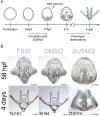FGF signalling plays similar roles in development and regeneration of the skeleton in the brittle star Amphiura filiformis
- PMID: 34042967
- PMCID: PMC8180256
- DOI: 10.1242/dev.180760
FGF signalling plays similar roles in development and regeneration of the skeleton in the brittle star Amphiura filiformis
Abstract
Regeneration as an adult developmental process is in many aspects similar to embryonic development. Although many studies point out similarities and differences, no large-scale, direct and functional comparative analyses between development and regeneration of a specific cell type or structure in one animal exist. Here, we use the brittle star Amphiura filiformis to characterise the role of the FGF signalling pathway during skeletal development in embryos and arm regeneration. In both processes, we find ligands expressed in ectodermal cells that flank underlying skeletal mesenchymal cells, which express the receptors. Perturbation of FGF signalling showed inhibited skeleton formation in both embryogenesis and regeneration, without affecting other key developmental processes. Differential transcriptome analysis finds mostly differentiation genes rather than transcription factors to be downregulated in both contexts. Moreover, comparative gene analysis allowed us to discover brittle star-specific differentiation genes. In conclusion, our results show that the FGF pathway is crucial for skeletogenesis in the brittle star, as in other deuterostomes, and provide evidence for the re-deployment of a developmental gene regulatory module during regeneration.
Keywords: Biomineralization; Echinoderm; Regulatory networks; Signalling; Vegf.
© 2021. Published by The Company of Biologists Ltd.
Conflict of interest statement
Competing interests The authors declare no competing or financial interests.
Figures







Similar articles
-
FGF signals guide migration of mesenchymal cells, control skeletal morphogenesis [corrected] and regulate gastrulation during sea urchin development.Development. 2008 Jan;135(2):353-65. doi: 10.1242/dev.014282. Epub 2007 Dec 12. Development. 2008. PMID: 18077587
-
Skeletal regeneration in the brittle star Amphiura filiformis.Front Zool. 2016 Apr 22;13:18. doi: 10.1186/s12983-016-0149-x. eCollection 2016. Front Zool. 2016. PMID: 27110269 Free PMC article.
-
Growth factor-mediated mesodermal cell guidance and skeletogenesis during sea urchin gastrulation.Development. 2013 Oct;140(20):4214-25. doi: 10.1242/dev.100479. Epub 2013 Sep 11. Development. 2013. PMID: 24026121
-
Role of FGFs/FGFRs in skeletal development and bone regeneration.J Cell Physiol. 2012 Dec;227(12):3731-43. doi: 10.1002/jcp.24083. J Cell Physiol. 2012. PMID: 22378383 Review.
-
Fibroblast growth factor signaling in skeletal development and disease.Genes Dev. 2015 Jul 15;29(14):1463-86. doi: 10.1101/gad.266551.115. Genes Dev. 2015. PMID: 26220993 Free PMC article. Review.
Cited by
-
Identification and localization of growth factor genes in the sea cucumber, Holothuria scabra.Heliyon. 2021 Nov 13;7(11):e08370. doi: 10.1016/j.heliyon.2021.e08370. eCollection 2021 Nov. Heliyon. 2021. PMID: 34825084 Free PMC article.
-
Distinct gene expression dynamics in developing and regenerating crustacean limbs.Proc Natl Acad Sci U S A. 2022 Jul 5;119(27):e2119297119. doi: 10.1073/pnas.2119297119. Epub 2022 Jul 1. Proc Natl Acad Sci U S A. 2022. PMID: 35776546 Free PMC article.
-
Ultrastructural and molecular analysis of the origin and differentiation of cells mediating brittle star skeletal regeneration.BMC Biol. 2021 Jan 18;19(1):9. doi: 10.1186/s12915-020-00937-7. BMC Biol. 2021. PMID: 33461552 Free PMC article.
-
Cambrian edrioasteroid reveals new mechanism for secondary reduction of the skeleton in echinoderms.Proc Biol Sci. 2022 Mar 9;289(1970):20212733. doi: 10.1098/rspb.2021.2733. Epub 2022 Mar 2. Proc Biol Sci. 2022. PMID: 35232240 Free PMC article.
-
The Role of Fibroblast Growth Factor (FGF) Signaling in Tissue Repair and Regeneration.Cells. 2021 Nov 19;10(11):3242. doi: 10.3390/cells10113242. Cells. 2021. PMID: 34831463 Free PMC article. Review.
References
-
- Altenhoff, A. M., Glover, N. M., Train, C. M., Kaleb, K., Warwick Vesztrocy, A., Dylus, D., de Farias, T. M., Zile, K., Stevenson, C., Long, J.et al. (2018). The OMA orthology database in 2018: retrieving evolutionary relationships among all domains of life through richer web and programmatic interfaces. Nucleic Acids Res. 46, D477-D485. 10.1093/nar/gkx1019 - DOI - PMC - PubMed
-
- Altenhoff, A. M., Levy, J., Zarowiecki, M., Vesztrocy, A. W., Dalquen, D. A., Müller, S., Swanson, B. J., Agrawal, A. D., Zucker, M., Stache-Crain, B.et al. (2019). OMA standalone: orthology inference among public and custom genomes and transcriptomes. Genome Res. 29, 1-12. 10.1101/gr.241141.118 - DOI - PMC - PubMed
Publication types
MeSH terms
Substances
Grants and funding
LinkOut - more resources
Full Text Sources
Other Literature Sources
Miscellaneous

